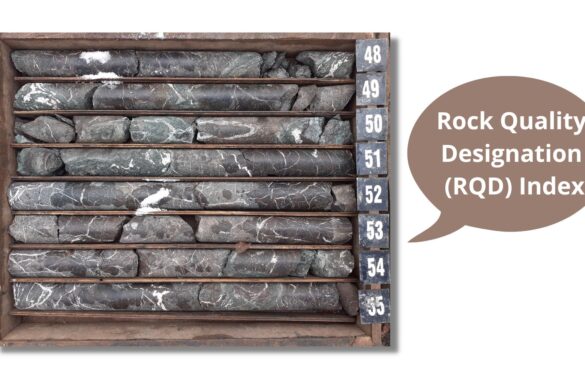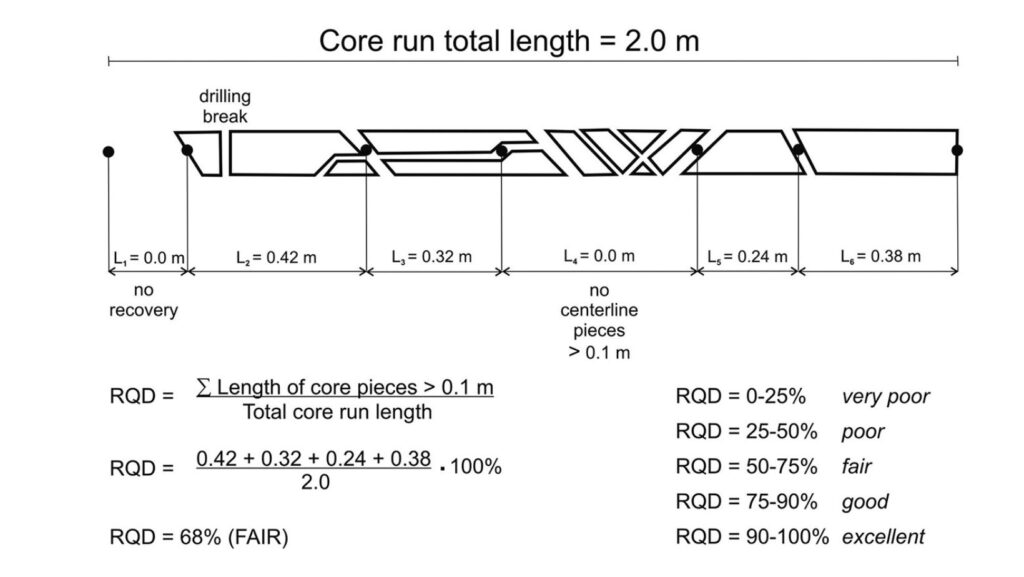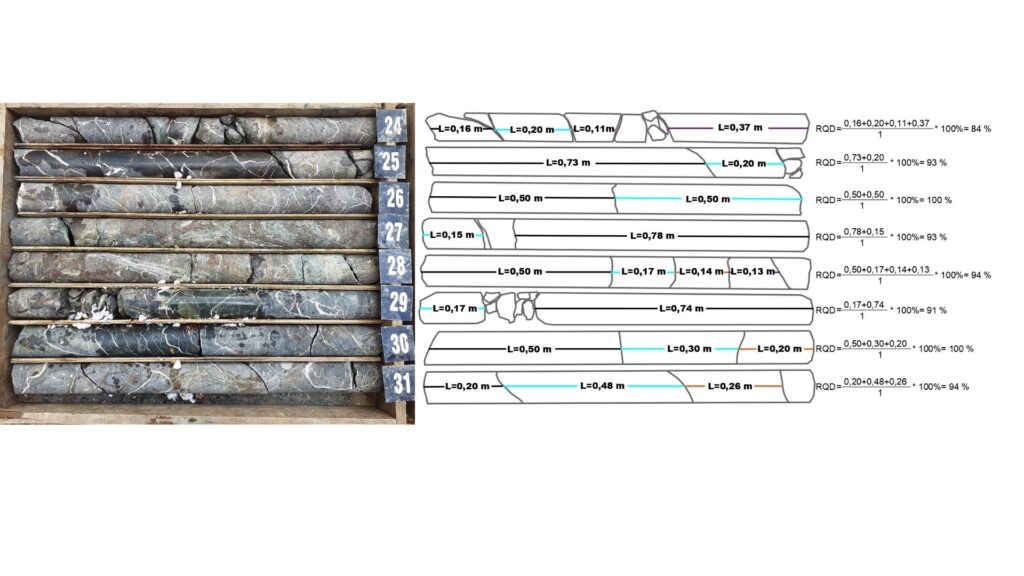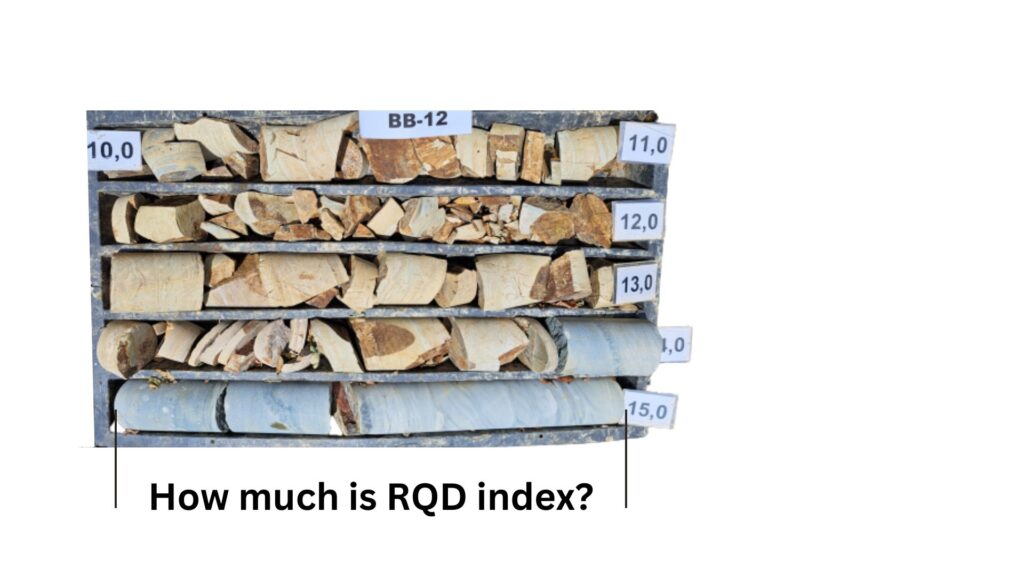Rock Quality Designation (RQD) Index

Introduction
Rock quality designation (RQD) is a widely used index in geotechnical engineering and rock mechanics for characterizing the quality of rock masses. RQD is an essential parameter for rock mass classification, which is necessary for the design and construction of various engineering structures such as tunnels, dams, mines, and slopes.
The Rock Quality Designation (RQD) formula is:
RQD = Sum of Lengths of Intact Rock Pieces/Total Length of Rock Core Sample × 100%
Where:
- Sum of Lengths of Intact Rock Pieces is the total length of intact rock pieces in the sample.
- Total Length of Rock Core Sample is the total length of the rock core sample.
The RQD index provides an objective and quantitative measure of the degree of fragmentation and the quality of the rock mass. This article will provide a detailed explanation of the RQD index, its applications, and the different categories of rock masses based on RQD.
Definition and Calculation of Rock Quality Designation (RQD) Index
RQD is defined as the percentage of the length of intact core pieces longer than 10 cm obtained from a borehole relative to the total length of the borehole. The RQD calculation involves measuring the lengths of the intact core pieces obtained from a borehole and adding the lengths of all pieces longer than 10 cm.
The sum of the lengths of these pieces is then divided by the total length of the borehole, and the result is expressed as a percentage. RQD values range from 0% to 100%, with higher values indicating a better quality of the rock mass.
Applications of Rock Quality Designation (RQD) Index
RQD is a crucial parameter in geotechnical engineering, and it has several applications, including:
Rock Mass Classification: RQD is used as one of the parameters for rock mass classification systems such as the Rock Mass Rating (RMR) and the Q-system.
Rock Strength and Deformation: RQD is used to estimate the rock strength and deformation properties, such as Young’s modulus and Poisson’s ratio.
Rock Stability Analysis: RQD is used to assess the stability of rock slopes and underground excavations by providing information on the degree of fracturing and the rock mass quality.
Geotechnical Design: RQD is used to design various geotechnical structures, such as tunnels, dams, and underground mines.
Categories of Rock Masses based on Rock Quality Designation (RQD) Index

The RQD values are used to classify rock masses into different categories, based on the degree of fragmentation and the quality of the rock mass. The categories of rock masses based on RQD are:
- Very Poor Rock Mass: RQD values less than 25% indicate a very poor rock mass, which is highly fragmented and has low strength and stiffness.
- Poor Rock Mass: RQD values between 25% and 50% indicate a poor rock mass, which is moderately fragmented and has moderate strength and stiffness.
- Fair Rock Mass: RQD values between 50% and 75% indicate a fair rock mass, which is less fragmented and has high strength and stiffness.
- Good Rock Mass: RQD values between 75% and 90% indicate a good rock mass, which is almost intact and has very high strength and stiffness.
- Excellent Rock Mass: RQD values greater than 90% indicate an excellent rock mass, which is completely intact and has extremely high strength and stiffness.
| RQD % | Quality |
| <25 | Very poor |
| 25–50 | Poor |
| 50–75 | Fair |
| 75–90 | Good |
| 90–100 | Very good |

RQD calculator
Relationship between spacing frequency and RQD index

Theoretical correlation between RQD and the velocity index

Authors and Development of Rock Quality Designation (RQD) Index
The concept of RQD was developed by Deere and Deere in 1967 as a means of quantifying the degree of fracturing and the quality of rock masses.
The method was based on the experience gained from site investigations carried out for various engineering projects, including the construction of tunnels and dams. Since then, RQD has become a widely accepted and essential index in geotechnical engineering and rock mechanics.
In addition to Deere and Deere, several other authors have contributed to the development and refinement of the RQD index. For example, Marinos and Hoek in 2000 proposed modifications to the RQD calculation to account for the presence of discontinuities, which can affect the accuracy of RQD values.
Similarly, Barton et al. in 1974 proposed a modified RQD index called the RQDjm index, which considers the joint spacing and orientation in addition to the core recovery.
Conclusion
The rock quality designation (RQD) index is an essential parameter in geotechnical engineering and rock mechanics for characterizing the quality of rock masses. The RQD index provides an objective and quantitative measure of the degree of fragmentation and the quality of the rock mass.
The RQD values are used to classify rock masses into different categories, based on the degree of fragmentation and the quality of the rock mass.
The categories of rock masses based on RQD are very poor, poor, fair, good, and excellent. The RQD index was developed by Deere and Deere in 1967, and it has been refined and modified by several other authors over the years.
Quiz Rock Quality Designation (RQD) Index

How much is RQD index in an interval of 14 to 15 meters?
Yes, you did well, the answer is 100%. (Excellent Rock Mass)
Guest author of the article: Mirza Djedović, B.Sc. geology
